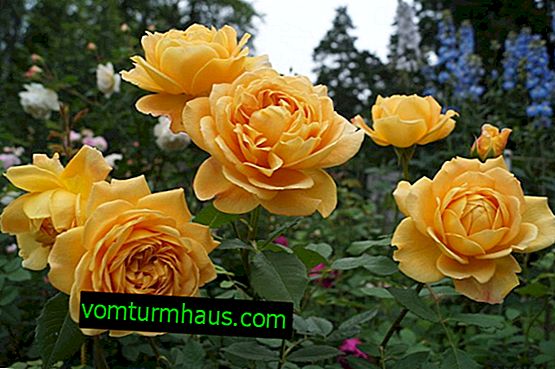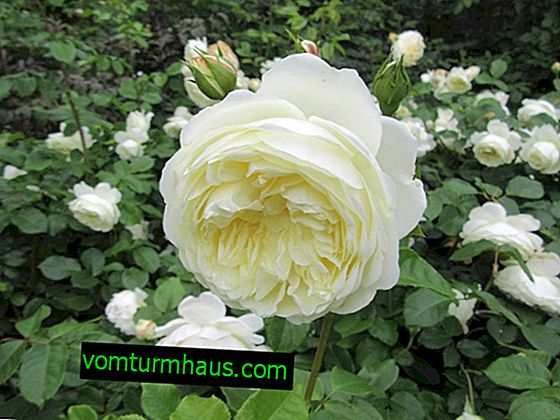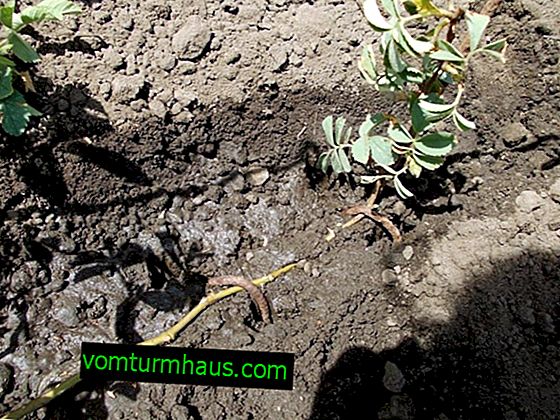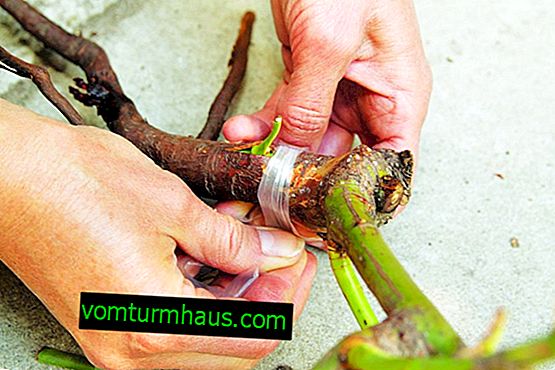Peony rose - description and features of care
Peony roses, or David Austin roses, have recently become increasingly popular among gardeners, as they are highly decorative and excellent resistance to environmental influences. A variety of varietal variations allows you to choose an acceptable option for each grower. And in order for the plant to really please with lush and stable flowering, it is important to take into account some care requirements, which will be discussed later.
Description of peony roses
Standard pink and red roses no longer surprise anyone, but if, in addition to them, a few more bushes of contrasting yellow or bright white colors are planted, you can noticeably transform the entire garden. Consider the features of several well-known varieties from each "color" group.
Pink varieties
Pink peony roses are usually associated with varietal names such as Constance Spray, Miranda, and Gertrude Jekyll. Pink color of flowers has different saturation. The size of the buds, the density of the petals and their terryness in any case will depend on the variety, so each of them deserves special attention:
- Constance Spray. An English variety bred in 1961. Shoots are climbing, grow up to 180 cm in height and 180 cm in width. Leaves are large, hard to the touch, with a matte surface. Flowers are densely doubled, with a diameter of up to 14 cm each bud. A characteristic feature of this variety is only the partial opening of the buds, and in the unopened part there are still many small petals.

Miranda. The variety is largely similar to the previous one, however, it appeared only in 2005. The flowers of this rose can combine bright and pale tones of pink with a wide variety of shades. The upper petals often have a delicate, almost white border, while the inner petals are characterized by a more saturated color. The diameter of each bud does not exceed 7 cm, and in height the bushes of the Miranda cultivar grow only up to 70 cm, with a width of 60 cm, which makes it not the highest representative of the pion-shaped variety of roses.

- Gertrude Jekyll . The flowers of the variety are terry, look like a flat rosette or a bowl, saturated pink color, with a sweet aroma of rose oil. Closer to the center of the bud, the color is more saturated. The height of the shoots is up to 120 cm, the width of the bush is 90 cm.

Did you know? Ecuador has long been engaged in the cultivation of long-lived roses that can stand in a cut for 5 to 10 months. The thing is in a special treatment involving the use of natural dyes based on rose oil.
Red varieties
Roses with red flowers have always been considered a symbol of passion and love, so they have not lost their relevance for hundreds of years. Pion-shaped specimens are no exception in this regard, because in addition to the saturated color, they also attract attention with large and lush flowers.
The following varieties can be considered the most interesting and attractive varieties of such flowers:
- Shakespeare . Fragrant variety of peony roses with bushy buds. Their shade often depends on the characteristics of the place of growth, therefore, varies from redder to purple. A large number of flowers are formed on the stems, which are combined into inflorescences of 3-5 pieces. The diameter of each bud usually does not exceed 8 cm.

Benjamin Britten Petals of this variety, in comparison with others, are tightly closed and remain so throughout the season. The shade of red and lush buds gives yellow or orange. The diameter of each of them does not exceed 12 cm, and in one inflorescence there are up to 3 pieces.

- Munstead Wood. Burgundy roses with medium sized buds. In one inflorescence, there are up to 5 flowers with a strong aroma, which intensifies when they open.

In addition to the described varieties of red rose, it is worth recalling the Othello variety. Although it is less common, it also has many advantages. For example, its flowers often reach 15 cm in diameter, which in combination with bright raspberry color makes them very noticeable in the garden.
Check out the varieties of extraordinary purple roses.
Yellow varieties
Yellow roses have more than a dozen varieties, among which many pion-shaped forms occupy honorable first places. For example, when choosing such colors, it is recommended to pay attention to the following varieties.
- Graham Thomas. The plant was bred in 1983 and still has not lost its popularity. The height of the bush is 1.5 m. The flowers of the variety are terry, medium (up to 10-12 cm), bright yellow in color with a peach tint.

Golden Celebration. One of the popular varieties of yellow rose, which is largely due to the presence of large double flowers with a diameter of up to 16 cm, the petals are of a honey-yellow hue. In each inflorescence there are 3-5 buds with a strong pleasant aroma.

Read also the description of the best varieties of yellow roses.
White varieties
Peony roses with a white color of flowers are not so many as the previous options, but they are also widely known among flower growers from different countries. The most common representatives from this group often include the following:
- Tranquility. A relatively new variety bred by English breeders only in 2012. Over the past few years, he managed to earn universal recognition, which is largely the merit of large white buds with a diameter of up to 12 cm. Petals are characterized by a slightly yellowish tint, but in the process of opening the bud, the white color becomes more saturated. Fully opened flowers have a very pleasant aroma, similar to apple, so they are perfect for planting in the garden, as well as for cutting into bouquets.

Claire Astin. Peony rose with cream-colored cup-shaped flowers. Compared with the previous versions, this plant has small buds with a diameter of 8-10 cm, but on each shoot not 1 flower is formed, but 2–3 flowers at once, which makes the shrub much richer and more magnificent in appearance. All the flowers of the plant exude a pleasant sweetish aroma.

- Alabaster. Variety with thick double flowers with a pleasant fragrant aroma. One inflorescence includes up to 5-6 buds, which are placed on tall stems and are great for creating bouquets.

Important! Roses of white varieties are not really pure white, but have certain shades: pinkish, yellowish, cream.
Dates and technology of planting roses
The best time for planting seedlings of this variety of roses is mid-spring, when the soil temperature in the selected place reaches + 8 ... + 10 ° C. In the northern parts of Russia, which are characterized by protracted and wet springs, it is advisable to land no earlier than mid-May or early June.

Before proceeding with the planting of the purchased seedling, you should know about the rules for its preparation. To strengthen the root system, it is necessary to sustain the plant in warm water with the addition of a growth stimulant for at least a day. While the seedling is being cultivated, it's time to start preparing the planting pit, the dimensions of which should be slightly larger than the size of the rhizome of the rose. At the bottom of the hole, it is desirable to lay small crushed stone, expanded clay, broken brick or any other material that can serve as drainage.
When planting on top of the drainage layer, it is necessary to spread the soil with a hill with the addition of complex fertilizers, and place a seedling on top, gently spreading its roots. The place of grafting should protrude above the soil surface by about 8-10 cm (about the reproduction of roses by grafting will be described below).
Also among gardeners, park roses are popular.
It is better to fill up the pit with the plant in small portions of the substrate, slightly compacting each layer. At the end of the procedure, the planted rose must be watered and the surface of the soil mulched with a layer of sawdust or straw, which will prevent excessive moisture evaporation.
Cultivation and care
Theoretically, care for a pion-shaped rose begins even before it is planted on the site, or rather, at the time of choosing the most suitable territory for the plant. In the future, gardeners should also understand the nuances of watering, fertilizing, pruning and preparing the plant for wintering.
Optimal conditions and location
Regardless of color and variety, peony roses can be planted both in single plantings and in combination with other flowers on the site. Illuminated and ventilated areas without drafts and possible stagnation of moisture are well suited for them, so it is better to plant rose bushes on a hill - this arrangement prevents decay of the root system of the plant.

Also, do not forget that these flowers do not tolerate accumulations of nitrogen and limestone in the soil, so it is advisable to choose places with neutral or slightly acidic soil. When planting in lowlands, with dense and waterlogged soils, good drainage is a prerequisite for a rose.
Watering and feeding
Watering of rose bushes of the described variety should be carried out only as necessary, that is, when the topsoil dries up. The frequency of this process directly depends on precipitation, therefore, during prolonged rains, flowers can not be watered for weeks - drying out the soil is not as dangerous for them as waterlogging.
See also why roses can turn black.
On average, about 5 liters of water are consumed per adult bush - of course, if we are not talking about climbing varieties that consume 10-15 liters. It is advisable to water it in the evening, so that under the scorching sunlight the moist earth does not become covered with a crust.
Fertilizing roses is possible only the next year after planting on the site, because until this time the flowers have enough nutrients introduced into the hole during planting.
In the future, with the advent of spring, plants should be fed monthly, using the following nutrients:
- rotted cow or horse manure, or chicken droppings - breed in the ratio of 1 glass per 1 bucket of water;
- rotted compost;
- wood ash;
- Ready-made mineral fertilizers for roses bought at any flower shop.

Before flowering, it is advisable to spray rose bushes with a solution of boric acid, for the preparation of which 1 g of the drug should be dissolved in 1 l of water and mixed thoroughly. Boron is also an excellent stimulator of bud formation.
From mid-August until the colds themselves, fertilizer peony roses are no longer needed, as the plants must stop their growth and build up the root system. Remember that shoots that are not lignified before winter can freeze.
Important! Yellowing and twisting of leaves on the bushes will testify to the saturation of roses with fertilizers. If this happens, any feeding will have to be stopped for a while.
Breeding
Peony roses are propagated in the same way as other varieties of these flowers, that is, cuttings, layering or grafting. Let's consider each method in more detail.
- The best time for grafting is August, when it is already possible to get suitable lignified shoots from adult bushes. It is from them that cuttings with 3 pairs of leaves are cut - however, before planting in the soil, the lower pair should be removed.

- Propagation by layering is carried out in the second half of the summer season, using long and completely healthy shoots of the mother plant. Having bent the selected part, at its end you need to make a small cut and, having fixed the shoot at the surface of the soil, sprinkle with soil.

- Propagation of roses by vaccination is the most time-consuming method of all of these, since it requires precision. Its essence is to perform several simple actions: first you need to make a T-shaped incision in the bark on a branch, insert an eye into it with a kidney of the selected rose variety, and then fasten them with a soft cloth.

Pruning and sheltering roses for the winter
Proper pruning is required in almost every variety of roses, since it not only contributes to the formation of lush buds, but also prevents the development of various ailments associated with thickening of plantings.
For the first time, pruning must be done after removing the shelter: carefully remove all dried and decayed shoots from the rose, and cut the healthy branches to a third of their length. If the bushes are grown as a living border, then they can be cut to a height of 60 cm.
Important! In the first summer after planting rose seedlings, it is advisable to remove all formed buds from them so that their development does not take vitality from the rest of the plant.
In the future, the pruning procedure should be repeated 2 times a year: in spring (for sanitary purposes) and in autumn (in preparation for wintering). In both cases, weak, unhealthy, broken, and sometimes just extra shoots are removed from the bushes so that they do not inhibit the development of the rose.
После осенней обрезки большинство сортов пионовидных роз необходимо правильно укрыть на зиму. Избавив растение от оставшейся листвы и обрезав зелёные и невызревшие ветви, стебли нужно либо сначала пригнуть к земле и закрепить, либо сразу засыпать слоем древесных опилок и соломы, при необходимости дополнительно укрывая их лапником, пластиковыми колпаками либо нетканым материалом.

Укрыть цветы желательно до того момента, когда температура снизится до –2…–5°С, так как примёрзшие розы в дальнейшем цветут не так активно, если вообще смогут пережить зиму. Смастерить укрытие также можно из деревянных или пластиковых дуг, с закреплённым на них плотным агроволокном, либо укрыть растения специальными чехлами-домиками, которые несложно найти в цветочных магазинах. Убирать укрытие можно при стабилизации температуры на отметке 0°С, после чего также стоит убрать слой мульчи от корневой системы.
Рекомендуем узнать основные правила обрезки роз на зиму.
Features of the flowering period
Практически все сорта пионовидных роз характеризуются ранним началом цветения, а некоторые из них за летний период цветут дважды. Конечно, второй раз цветы уже не будут такими большими, но зато куст успеет полностью вызреть до наступления холодов, что в дальнейшем существенно облегчит подготовку к зиме.

Недостатком пионовидных разновидностей в плане цветения выступает высокая чувствительность цветков к повышенной влажности, что часто приводит к загниванию бутонов. Кроме того, не лучшим образом на них сказывается летний зной, из-за которого цветки мельчают, а период цветения сокращается чуть ли не вдвое.
На участке своим цветением также радуют сорта канадских и английских роз.
Possible growing difficulties
При правильной организации ухода за розами никаких проблем с ними быть не должно, однако нельзя полностью исключать возможность развития заболеваний или повреждения вредителями.
Среди самых распространённых проблем такого плана можно выделить появление на розе мучнистой росы, чёрной пятнистости или корневой гнили, в дополнение к которым иногда приходится сталкиваться с тлёй или щитовками.

Как используются в ландшафтном дизайне
В период, когда цветут пионовидные розы, весь сад приобретает яркие краски, причём совершенно неважно, выращиваются эти цветы как одиночные растения либо они включены в состав розариев или альпийских горок вместе с иными многолетними и однолетними цветущими культурами.
Высокорослые сорта могут высаживаться для создания живых заборов или вертикального озеленения с применением металлических опор. Эти разновидности отлично смотрятся вместе с такими цветами, как наперстянка или дельфиниум.

Среднерослые сорта пионообразных роз будут выигрышно выглядеть вместе с аконитом, флоксами, вероникой или шалфеем, а для лучшего эффекта на передний план можно дополнительно высадить низкорослые сорта, причём не только пионовидных роз, но и чайно-гибридных (например, сорт Августина Луиза).
Также к чайно-гибридным сортам роз относят Осирию, Аваланж и Мондиаль.
В весеннее время, до распускания бутонов, разнообразить посадки можно с помощью весеннецветущих луковичных растений, вроде крокусов, гиацинтов, нарциссов, тюльпанов, а для украшения участка в осенний сезон рядом с розовыми кустами можно высадить классические пионы.
Пионовидные розы — отличный вариант как для выращивания в саду, так и для посадки в контейнер, поэтому с их помощью каждый цветовод сможет организовать на своей территории высокодекоративный уголок. Большое разнообразие сортовых вариаций позволяет сочетать между собой самые разные цвета и оттенки, а дополнительным преимуществом при выращивании таких роз будет сравнительная простота ухода.

















